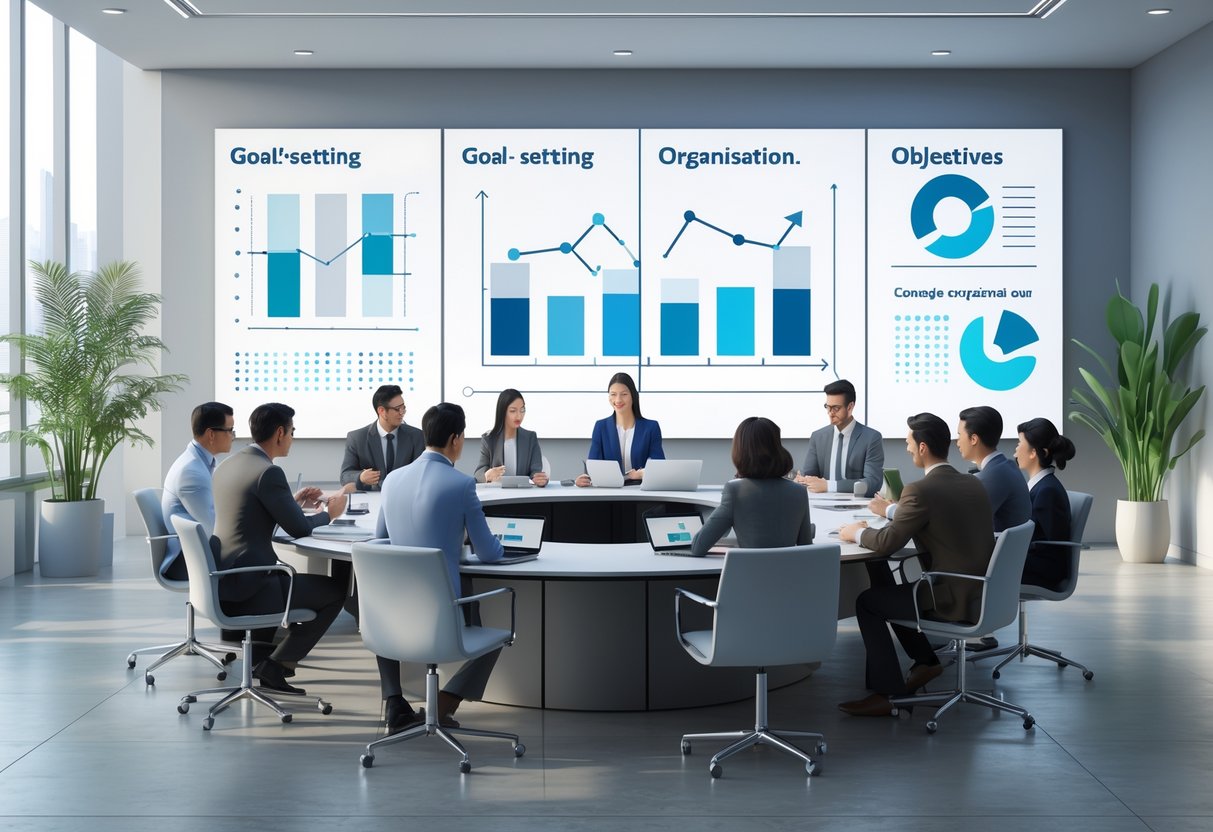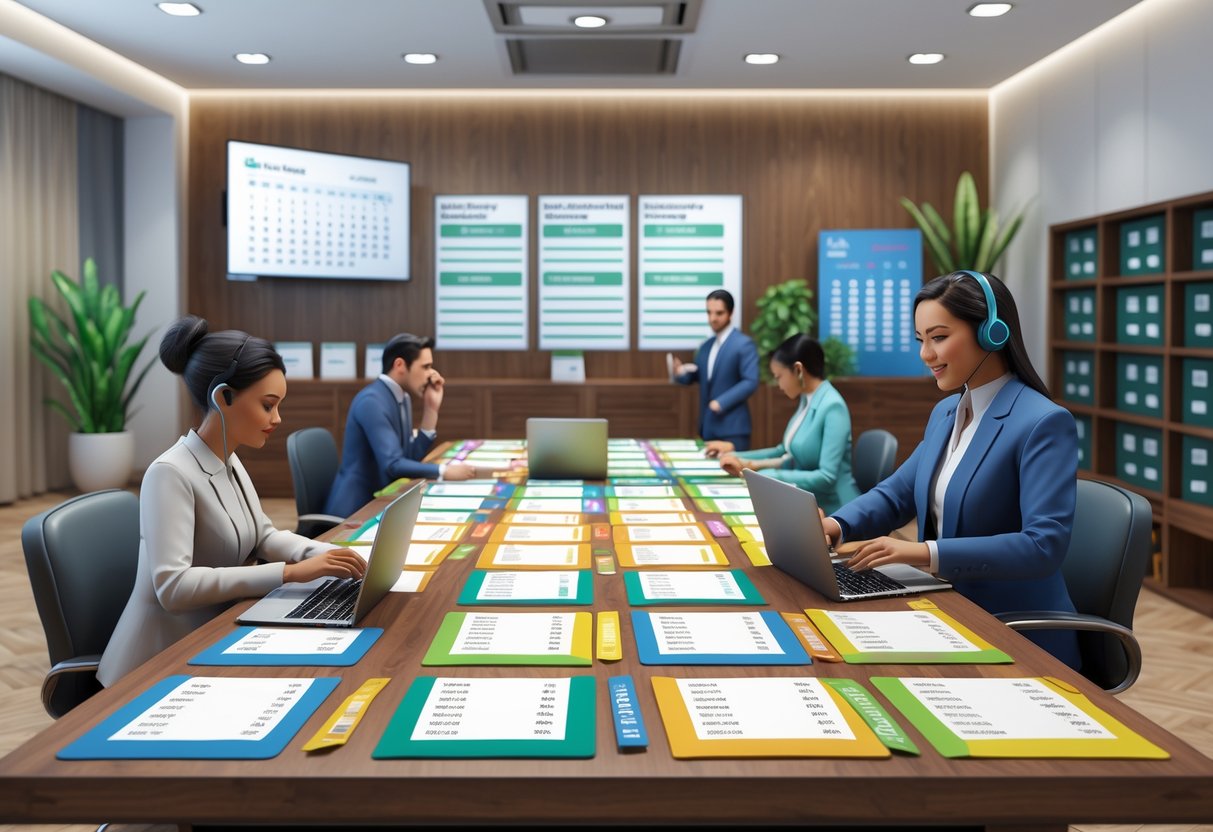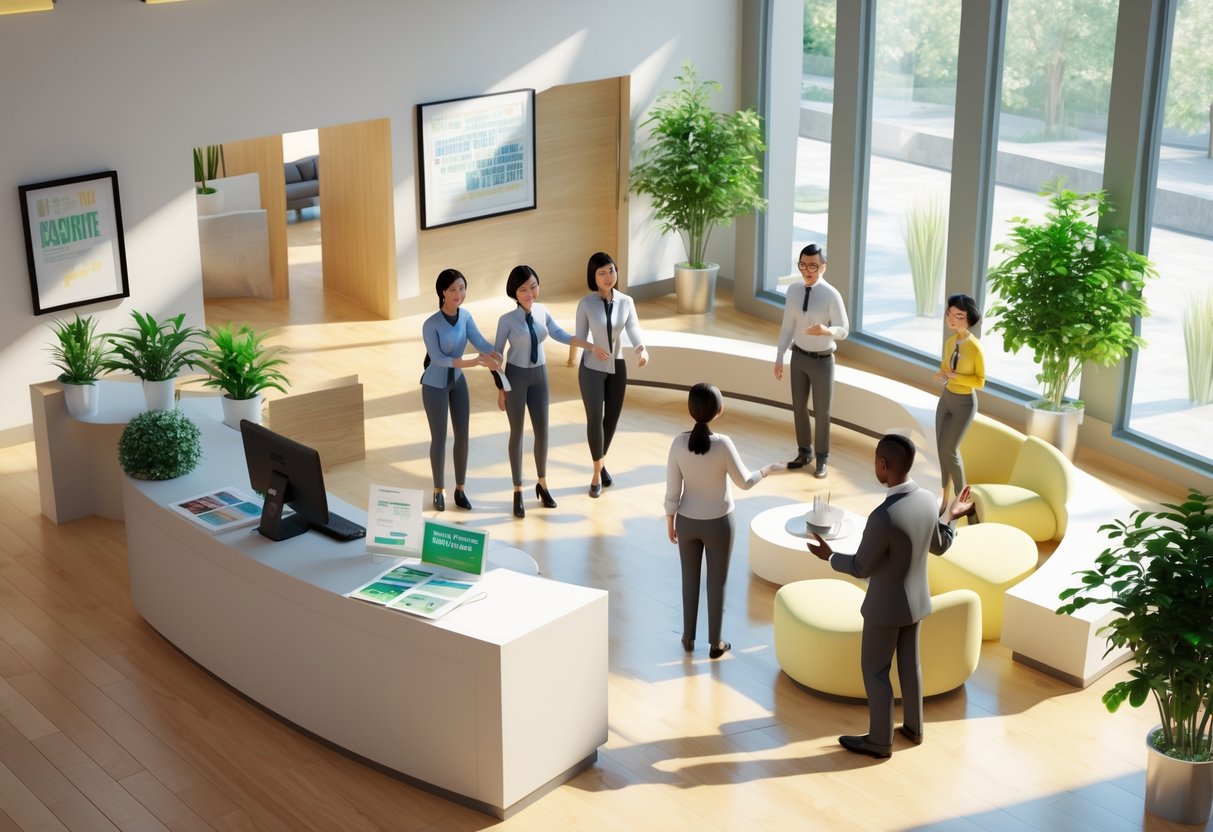Meet and Greet Organisation: Guide to Successful Professional Events
Updated On: October 23, 2025 by Aaron Connolly
Defining Meet and Greet Organisation
Meet and greet organisation means planning networking events that connect people for professional or social reasons. These events have clear goals—maybe building relationships, finding business opportunities, or just helping attendees make meaningful connections.
Purpose of Meet and Greets
Professional relationship building sits at the heart of most meet and greet events. We put these gatherings together to help people grow their networks and form business connections that might actually last.
Business development also drives a lot of these events. Companies often use meet and greets to show off new products, services, or introduce new team members to clients—both old and new.
Community engagement gets organisations hosting meet and greets to strengthen local ties. These events pull in people who have something in common or share a goal.
You might use a meet and greet to:
- Introduce new faces or leaders
- Recruit volunteers or members
- Build up your brand
- Celebrate a big achievement
- Find new leads or partners
The best events stick to one main purpose instead of trying to do everything at once.
Types of Meet and Greet Events
Corporate networking events gather industry professionals in pretty formal spaces. You’ll usually find these in hotels, conference centres, or company offices.
Community gatherings are more relaxed and let locals connect. Libraries, community centres, and parks tend to host these.
Virtual meet and greets rely on video calls to bring people together from anywhere. Especially lately, these have exploded in popularity since they’re cost-effective and reach more folks.
| Event Type | Duration | Typical Venue | Best For |
|---|---|---|---|
| Corporate | 2-3 hours | Hotels, offices | Professional networking |
| Community | 1-2 hours | Libraries, parks | Local connections |
| Virtual | 1 hour | Online platforms | Remote networking |
Industry-specific events focus on one sector—think tech, healthcare, or education. People show up because they share professional interests.
Key Benefits for Attendees
Network expansion gives the quickest win to anyone at a meet and greet. People usually walk away with new contacts and possible collaborations.
Professional development just happens when you talk to experienced folks in your field. You’ll often pick up insights or career tips you didn’t expect.
Business opportunities pop up from the connections you make. Plenty of attendees end up with new clients, partners, or even jobs after a good networking event.
You might also get:
- Learning opportunities from experts
- Confidence boosts from practising your networking
- Market insights from peer conversations
- Mentorship links with pros who’ve seen it all
The casual vibe at these events helps shy or introverted people join in more easily than at huge, formal conferences.
Setting Clear Objectives

Before you plan any meet and greet, define what success actually means and make sure your goals line up with what your esports organisation really needs right now.
Identifying Event Goals
When you’re putting together an esports meet and greet, start with specific goals. Don’t just hope things fall into place. Different events serve different needs in the gaming world.
Common meet and greet objectives:
- Building professional relationships among players, coaches, and industry folks
- Introducing new team members or staff
- Recruiting talented players or volunteers for future tournaments
- Landing sponsorships or partnership deals
- Celebrating big wins or team milestones
Write down two or three real goals before you get too far. For example, “Connect 15 local streamers with our coaching staff” or “Introduce our new analyst team to the players.”
Make sure each goal is measurable. Instead of “improve networking,” try “help 20 new Discord connections happen between attendees.”
Professional development often follows naturally when you connect the right people. Players meet coaches, streamers find tournament organisers, and content creators discover new partners.
Aligning Objectives with Organisational Needs
Your meet and greet goals need to back up what your esports organisation wants this season. No point running a recruitment event if your roster’s already full.
Ask yourself:
- Are we moving into new games?
- Do we need more community engagement before big tournaments?
- Are we launching new training or coaching services?
- Is brand visibility our main focus right now?
Match event goals to your timeline:
| Organisational Need | Meet & Greet Focus | Expected Outcome |
|---|---|---|
| Player recruitment | Talent showcase events | 5-10 new tryouts |
| Sponsor acquisition | Industry networking | 3-5 partnership meetings |
| Community growth | Fan engagement | 50+ new followers |
| Team building | Internal connections | Stronger player relationships |
Think about your resources, too. A small community group won’t have the same goals as a big esports team with pro players.
Quick tip: Schedule your meet and greet a few weeks before big moments like tournament announcements or season launches.
Determining the Event Format

Choosing between in-person and virtual formats changes everything about your event. Each style has its own perks for connecting people and building relationships that matter.
In-Person Meet and Greet Organisation
In-person events spark real connections through face-to-face chats. People can read each other’s body language and just talk naturally, maybe over snacks.
Venue Selection Considerations:
- Capacity: Pick a space that fits your guest list
- Layout: Open spaces make mingling easier
- Accessibility: Make sure everyone can get in and out easily
- Atmosphere: Hotels work for corporate events; community centres are great for casual gatherings
Keep events short—1 to 2 hours max. This keeps people engaged and avoids burnout.
Physical must-haves:
- Big, easy-to-read name tags with first names and organisations
- Coat check if it’s cold out
- Registration table with friendly staff
- Snacks and drinks you can hold while chatting
Plan icebreakers every half hour or so. Things like speed networking, bingo, or trivia break the ice for shy folks.
Virtual Meet and Greet Options
Virtual meet and greets use video calls to connect people wherever they are. This saves on travel and lets you invite more people.
Platform must-haves:
- Good video quality
- Breakout rooms for small group chats
- Screen sharing for presentations
- Chat features for side conversations
Keep online events short—60 to 90 minutes is plenty. People’s attention online just doesn’t last as long as it does in person.
How to keep people engaged:
- Send digital name tags or suggest fun backgrounds
- Use polls for icebreakers
- Schedule quick breaks every half hour
- Share tech support contacts ahead of time
Hybrid events are worth considering. Some people can join in person, while others tune in online.
Constructing the Guest List

Your guest list pretty much decides the vibe and success of your meet and greet. The right mix of people makes for good conversations and balanced networking.
Selecting Invited Participants
Start by mapping out your professional network and spotting key people in your esports scene. Try sorting them into groups like industry veterans, content creators, players, and business partners.
Mix up experience levels. When you bring together pros and newcomers, you get natural mentoring and fresh energy.
Invite folks like:
- Tournament organisers and event staff
- Pro players and coaches
- Content creators and streamers
- Sponsors and brand reps
- Media and journalists
Reach out to your top-priority guests early. Esports people can get booked up fast, especially around tournaments.
Keep track of who’s coming with a spreadsheet or event tool. Note their contact info, dietary needs, or anything special.
Balancing Internal and External Guests
You need both your team and outside contacts on the guest list. We usually aim for about 60% external guests for the best networking.
Internal guests are your staff, partners, and regular collaborators. They help make the event welcoming and smooth.
External guests bring new ideas and opportunities. Try to include people from different parts of esports—game developers, broadcasters, gear makers.
Internal guest examples:
- Core team members
- Regular streaming partners
- Sponsored athletes
- Advisory board
Don’t invite too many folks from competing organisations at once. That can get awkward.
Make sure your internal team knows they’ll be introducing people and starting conversations.
Maximising Engagement
Build your guest list to encourage real conversations. We find 30–50 people is a sweet spot for mingling.
Do your homework before the event. Find out what your guests are working on or what interests them. Then you can introduce the right people.
Group attendees with similar interests or skills. Maybe pair new streamers with established creators.
How to boost engagement:
- Plan icebreaker activities
- Group by game or specialty
- Mix experience levels for mentoring
Send out info ahead of time so guests can prep for good conversations. If possible, share the attendee list so people can spot who they want to meet.
Follow up after sending invites. A personal message or call goes a long way toward getting folks to show up.
Event Planning Essentials

Getting the basics right is what makes a successful networking event. Venue, timing, and budget—the big three—decide if your event hits the mark or disappoints.
Choosing the Right Venue
Your venue sets the mood for the whole event. If it’s cramped, people can’t talk. If it’s too big, small groups feel lost.
What to look for:
- Open layout for easy mingling
- Capacity that fits your expected crowd, plus a little extra
- Good location with parking or public transport
- Flexible furniture you can move around
Hotels or conference centres work well for business events. Community centres or modern offices are great for more casual meet and greets.
Ask venues:
- Can we rearrange furniture?
- Are there spaces for small group chats?
- What tech is included?
- Is there coat storage?
Check the acoustics before booking. Hard surfaces make everything echo, which is annoying. Carpets and soft chairs help keep noise down.
Scheduling and Timelines
Timing really matters for turnout. Most people like early evening (5:30–7:30pm) after work.
Tips for scheduling:
- Duration: Keep it under 2 hours
- Weekdays: Tuesday to Thursday is best for business events
- Weekends: Better for community meet and greets
- Advance notice: Send invites 4–6 weeks ahead
Make a simple timeline for your team:
| Time | Activity | Responsible Person |
|---|---|---|
| 30 mins before | Setup, registration table | Setup team |
| First 15 mins | Guests arrive, hand out name tags | Registration staff |
| Opening 10 mins | Welcome, icebreaker | Event host |
| Main 60-90 mins | Networking, snacks | All team members |
| Final 15 mins | Closing, exchange contacts | Event host |
Heads up—don’t schedule your event during major sports, school holidays, or big industry conferences. That’s just asking for no-shows.
Budgeting and Resource Management
Smart budgeting helps your meet and greet deliver value without blowing the budget. Most successful events put about 40% toward the venue, 30% to refreshments, 20% to marketing, and 10% to miscellaneous stuff.
Essential budget categories:
- Venue hire: £200-800, depending on where and how long you need it
- Refreshments: £8-15 per person if you want decent finger food and drinks
- Marketing materials: £100-300 for things like invitations, name tags, and signage
- Staffing: Don’t forget volunteer coordination or any paid help
Quick win: Try partnering with local businesses for sponsorship or in-kind donations. Sometimes a neighborhood café will provide snacks if you give them a shout-out at your event.
A few cost-saving tricks:
- Book venues during off-peak hours to get better rates
- Go digital with invitations instead of printing them
- Grab name tags and basic supplies from discount shops
- Ask for volunteers from your own group or network
Free alternatives are out there too. Public libraries often have meeting rooms, universities sometimes share their spaces, or you could use an outdoor venue if the weather’s on your side. Local councils might have community rooms for cheap or even free.
Keep an eye on your spending as you plan. Compare actual costs to your budget so you know where the money’s going and get better at planning for next time.
Invitation and Communication Strategies
Invitations and clear communication channels can make or break your turnout. If you handle RSVPs well, you’ll have smoother event logistics and stronger relationships with your guests.
Crafting Invitations
Your invitation sets the whole vibe for the event. Start with a subject line that clearly says what the event is and the key details.
Include the basics in this order:
- Purpose of the meet and greet
- Date and time (with both start and end times)
- Venue address and postcode
- Host info and any key guests
- Dress code if you have one
- RSVP deadline and how to get in touch
Professional tone matters. For corporate networking, stick to formal language. For casual gatherings, keep it friendly. Always address people by name if you can—nobody likes “Dear Guest.”
Show what’s in it for them by mentioning specific benefits. Maybe they’ll meet industry leaders, get access to exclusive resources, or find new collaborators.
| Event Type | Sample Opening |
|---|---|
| Corporate networking | “Join senior executives for an exclusive industry roundtable…” |
| Team introduction | “Meet our new department heads over coffee and pastries…” |
| Client event | “Connect with fellow innovators at our quarterly mixer…” |
Channels for Sending Invitations
Pick your channels based on who you’re inviting and how formal the event is. Email works best for professional stuff—plenty of space for details and easy to forward.
Digital platforms are great for more modern events:
- LinkedIn messages for industry folks
- Slack or Teams for internal get-togethers
- Or mix it up: send an email and add social sharing options
Physical invitations feel special for formal galas or VIP events, but they’ll cost more and take longer to send.
Quick win: For big events, use more than one channel. Email first, then call your key attendees.
Think about what your guests actually use. Some older professionals might prefer a phone call, while younger folks usually like digital invites with social sharing.
RSVP Management Techniques
Set up a system to track responses. Spreadsheets work for small events, but bigger ones might need an event management platform.
Follow-up plan:
- Send the first invitation 2-3 weeks before the event
- Remind people a week before the RSVP deadline
- Send a final reminder 2-3 days before
- Confirm with those who’ve said yes
Ask about dietary needs and accessibility when you collect RSVPs. This keeps things smooth and shows you care.
Plan for no-shows. Usually, 10-15% of people who confirm won’t actually turn up.
Heads up: Don’t rely only on digital RSVPs. Offer phone and email options for those who aren’t comfortable online.
Use RSVP data to make the event more personal. Group similar professionals together or prep conversation starters based on who’s coming.
Creating a Welcoming Atmosphere

First impressions really do set the tone. If you prepare the venue, add clear signs, and greet people thoughtfully, attendees will feel comfortable and ready to connect as soon as they walk in.
Venue Preparation
We need to turn the space into a networking-friendly environment before anyone shows up. The layout should make it easy for people to move around and start conversations.
Arrange furniture to promote mingling. Push chairs back or against the wall to open up space. Scatter a few small standing tables so people can gather in groups of three or four.
Test all technical equipment early. Check microphones, speakers, and any other gear you’ll need. Bring backups just in case.
Create comfortable temperature and lighting. Get there half an hour early to sort out heating or air con. Lighting should be bright enough for reading name tags, but not harsh.
Designate areas for different things. Put a registration table by the door. Place food and drinks somewhere central so people naturally gather. Set up a quiet spot for coats and bags.
Remove anything that blocks movement. Keep walkways clear so people can move easily between groups.
Signage and Navigation
Clear signs make people feel at ease and stop them worrying about getting lost.
Put welcome signs at the entrance. Add your event name, logo, and a quick welcome. Point the way to registration if it’s not obvious.
Use simple signs for key spots. Mark:
- Registration/check-in
- Refreshments
- Toilets
- Coat storage
- Emergency exits
Display the agenda somewhere everyone can see. List when things like presentations or networking sessions start.
Keep design professional but friendly. Make sure text is big enough to read from a couple of metres away. Stick to your brand colours but make sure there’s enough contrast.
Set up name tag stations with markers. Let people tweak or update their name tags as needed.
Onboarding and Greeting Procedures
How we greet people shapes their experience and how likely they are to network.
Put greeters at the entrance. Friendly team members should welcome each person with a smile and eye contact. Use phrases like “We’re delighted you’re here.”
Make check-in quick. Prepare name tags ahead of time. Organise registration lists alphabetically. Use a few check-in stations if you’re expecting a crowd.
Give a quick orientation. After check-in, point out the layout, highlight important areas, and mention what’s happening next. Tell newcomers where to get refreshments and when things kick off.
Help people meet each other. Train greeters to introduce guests with similar interests. This helps break the ice right away.
Start with a short welcome activity. Try a simple icebreaker that gets everyone talking in the first 15 minutes. Maybe ask people to introduce themselves to three new folks before the first presentation.
Facilitating Networking Opportunities

Breaking the ice and creating structure helps people make real connections. These strategies take the awkwardness out and guide the conversation.
Icebreaker Activities
Simple games get people talking. Speed networking is a classic—everyone rotates partners every few minutes, and you can give prompts like “What’s your biggest goal this year?”
Networking bingo is fun too. Make cards with things like “someone who’s changed careers” or “speaks three languages.” People mingle to find matches and learn about each other.
Two truths and a lie works for small groups. Everyone shares three statements about their background, and the others guess which one’s made up.
Human scavenger hunts are great for bigger groups. Give out lists of achievements or experiences for people to find in others. It always leads to more interesting chats.
Keep activities short and explain the purpose before you start. This helps nervous guests feel more comfortable.
Structured Networking Sessions
Topic-based roundtables let people group up by interest or industry. Rotate every 15-20 minutes. Assign someone to lead the discussion and keep things moving.
Mentor-mentee matching pairs experienced pros with newcomers. Use short questionnaires to match people by personality and goals. These usually work best as 20-minute one-on-ones.
Problem-solving workshops get people collaborating. Throw out an industry challenge and have small teams tackle it. People bond over working together instead of just chatting.
LinkedIn connection sessions give everyone a chance to connect digitally while meeting face-to-face. It’s a good way to keep the networking going after the event.
Keep sessions short and offer breaks. That way, no one gets overwhelmed, and introverts get a breather.
Incorporating Mentoring Components

Adding mentoring elements to your meet and greet gives people real growth opportunities. You can connect experienced professionals with newcomers through targeted invites and simple program tweaks.
Inviting Mentors and Key Speakers
Identifying the Right Mentors
Focus on people who love sharing knowledge instead of just big names. Look for industry veterans who’ve actually helped others grow.
Some mentor profiles to consider:
- Technical specialists with 5+ years experience
- Team leaders who manage junior staff
- Career changers who get transition challenges
- Industry pioneers with unique stories
Crafting Compelling Invitations
Be clear about what you’re asking—busy people appreciate knowing what’s involved.
Include:
- Time commitment (like “2-hour total commitment”)
- What’s in it for attendees
- The focus on professional development
- Any follow-up opportunities
Setting Mentor Expectations
Brief mentors on who’s coming and what they might ask. This helps them give better advice.
Give mentors:
- Info on attendee skill levels and interests
- Common challenges newbies face
- Conversation starters
- Guidelines for swapping contact info
Mentorship Programme Integration
Structured Mentor-Attendee Matching
Set up a simple system to match attendees with mentors based on interests and experience. This makes short conversations more valuable.
Matching criteria:
- Career stage
- Technical skills
- Industry sector
- Communication style
Creating Meaningful Exchanges
Short sessions work best when you give people a conversation guide.
Try this structure:
- Opening question about current goals
- Mentor shares experience
- Specific advice for next steps
- Resource recommendations for learning more
Follow-up Mechanisms
Make it easy for people to keep in touch after the event. You might offer contact cards or referrals to more formal mentorship programs.
Options include:
- Contact exchange cards for those who want to stay in touch
- Monthly mentor meetups for longer-term relationships
- Workshops led by mentors
- Online community access for ongoing chat
Running the Meet and Greet Event
The day of the event is all about smooth execution and handling problems on the fly. Stay organised, but remember to keep the energy up and enjoy the gathering too.
On-the-Day Checklist
Get there at least an hour before your first guests. That way, you can set up without feeling rushed.
Set-up priorities:
- Test audiovisual equipment right away
- Move furniture so people can mingle easily
- Put the registration table right by the entrance
- Lay out name tags and markers
- Adjust lighting and check temperature controls
Welcome station essentials:
- Printed guest list with tick boxes
- Extra name tags and pens
- Event programmes or agendas
- Contact sign-up sheets
Talk to your team about their roles before anyone arrives. Make sure everyone knows what they’re handling.
Always have a backup plan. If the weather turns or something breaks, you’ll want some quick fixes ready.
Final 15-minute check:
- Set music to a comfortable volume
- Make sure food and drinks are out
- Check that toilets have supplies
- Keep emergency contact numbers close
Managing the Agenda
Keep your agenda in view, but don’t be afraid to change things on the fly. Use a small board to show timing so your team can keep up.
Once most people are in, start with a short welcome. Introduce yourself and share the event’s purpose—try to keep it under two minutes.
Timing breakdown for 90-minute events:
- Welcome and introductions: 10 minutes
- First networking block: 30 minutes
- Icebreaker activity: 15 minutes
- Second networking block: 25 minutes
- Closing remarks: 10 minutes
Walk around during networking. Link up people with similar interests. If you spot someone hanging back, mention a shared hobby or background to help them join in.
Give soft time warnings before moving on. A simple “We’ll start our next activity in five minutes” keeps everyone on track.
Pay attention to the vibe in the room. If people look tired, cut back on formal stuff. If conversations are buzzing, let networking run a bit longer.
Troubleshooting Common Issues
Late arrivals: Assign someone to greet them. Fill them in fast and introduce them to a couple of people right away.
Awkward silences: Have some conversation starters in your pocket. Ask about work, hobbies, or how they found out about the event.
Dominating personalities: Gently steer the conversation. “That’s interesting, John. Sarah, what’s your experience with this?”
Technical problems: Always plan for tech to break. If the mic dies, just speak up and get closer to your group. If the projector goes out, carry on without slides.
Food shortages: Order about 10% extra beyond your RSVP list. Keep some backup snacks like crisps or biscuits just in case.
No-shows: Expect about 20-30% of people won’t turn up. It’s normal—don’t let it bother you.
Venue issues: Get there early to spot any problems. Have your venue contact’s number handy. Know where to go if you need a backup space.
Post-Event Follow-Up and Engagement
A great meet and greet doesn’t really end when people leave. The real value? It’s in the feedback you collect and the connections you keep going with some thoughtful follow-up.
Gathering Feedback
Get attendee feedback while the event’s still fresh for them. Send feedback surveys within a day or two, while people remember the details.
Keep surveys short and focused. Ask just 3-5 questions about what worked and what didn’t. Use rating scales for venue, networking, and overall satisfaction.
Think about feedback on:
- Event timing and duration
- Venue accessibility and comfort
- Quality of networking
- Registration and check-in flow
- Food and drink
Offer more than one feedback channel. Set up a feedback station at the event or use QR codes for quick mobile forms. Some folks will just want to chat and give feedback right away.
If someone hasn’t responded, send one gentle reminder after a week. Don’t keep chasing—one follow-up usually does the trick.
Nurturing Ongoing Relationships
Turn those new contacts into real professional relationships by staying in touch. Send thank-you notes within a week, and mention something you talked about.
Add value after the event. Share a useful article, an industry update, or news about another event they might like. That way, you stay on their radar without being annoying.
Set up regular ways to reconnect:
- Monthly newsletters
- Quarterly coffee meetups for locals
- Annual reunion events
- LinkedIn invites with a personal note
Help attendees stay connected too. If you know two people had similar challenges or skills, introduce them after the event. You’ll look like the ultimate connector.
Use social media wisely. Make an event hashtag and encourage people to share photos. Tag guests in posts, and celebrate their wins if it fits.
Analysing Outcomes
Track success with real numbers, not just good vibes. Look at metrics like how many showed up, how many filled out surveys, and how many booked follow-up meetings.
Keep a basic tracking system for post-event connections. Jot down which intros led to real business or collaboration. This info helps you plan better next time.
Watch these metrics:
- How many attendees connected on LinkedIn
- Number of follow-up meetings
- Survey completion and satisfaction scores
- Social media engagement and mentions
- Repeat attendance at future events
Write down lessons learned right after the event. What time worked best for your crowd? Which icebreakers actually got people talking? Keep those notes for next time.
Work out the cost per real connection. Add up venue, food, and staff time. This helps you justify your budget and spot where you can save next time.
Frequently Asked Questions

If you want to plan a great meet and greet, you need the right icebreakers, engaging activities, and a knack for making lasting impressions. Here are some of the most common questions, from networking tips to how to make your invitations stand out.
What are some professional ice-breaker activities for corporate meet and greets?
Speed networking is a winner for corporate events. Set up 5-minute rounds so everyone gets to meet.
Professional bingo makes conversations easier. Use cards with things like “has worked remotely for 3+ years” or “speaks three languages.” Guests mingle to find matches.
Industry trivia keeps things fun and team-based. Ask questions about your field or your company’s history. Have groups of 4-5 work together.
Two truths and a lie lets people share unexpected facts. Each person says three things, and the group guesses what’s made up.
Could you provide some engaging ideas for organising a fun and interactive meet and greet?
Scavenger hunts get people moving and talking. Try prompts like “find someone who’s traveled to five countries” or “find a birthday twin.”
Photo booth stations with props are a natural icebreaker. Use backgrounds that fit your group or theme.
Interactive workshops blend networking and learning. Quick 20-minute sessions on “elevator pitch practice” or “LinkedIn tips” work well.
Food and drink stations scattered around the space encourage people to mingle. Put different snacks in different spots so guests move around.
Live polls using apps get everyone involved. Ask fun questions like “coffee or tea?” and show the results on a screen.
What essential elements should be included in a meet and greet programme timetable?
Welcome and check-in should last 15-20 minutes. This gives latecomers a chance and lets people settle in.
Opening remarks don’t need to be long—5-10 minutes is plenty. Introduce the purpose, key people, and the basics like where the toilets are.
Networking blocks work best in 20-30 minute bursts. Mix up free mingling and guided activities to keep things lively.
Refreshment breaks every 45 minutes keep energy up. Place food and drinks where people will find new folks to talk to.
Closing remarks can be done in five minutes. Thank everyone, share next steps, and mention how they can stay connected.
Buffer time of 10-15 minutes between activities helps avoid a rushed feeling.
How can you make a good impression at a celebrity meet and greet event?
Plan your conversation ahead, but don’t over-rehearse. Have two or three real questions or comments about their latest work.
Stick to time limits. You usually get 30-60 seconds, so make it count.
Bring something meaningful if gifts are allowed. Handwritten notes or art mean more than pricey gifts.
Stay calm and be yourself. Celebrities notice authenticity more than a perfect speech.
Follow the photo rules. Some events allow selfies, some don’t. Ask staff if you’re not sure.
Show real appreciation for their work. Mention something specific so they know you care.
What are the key points to cover in a meet and greet meeting’s agenda?
State the event objectives right at the start. Whether it’s networking, fundraising, or celebrating, everyone should know the purpose.
Share a detailed timeline with start and end times for each part. This helps guests plan their day.
Give out logistics info like venue layout, parking, and accessibility so no one’s left guessing.
Introduce key people so guests know who to ask for help.
List interactive elements like icebreakers or networking activities so folks know what’s coming.
Explain follow-up plans so guests know how to keep in touch after the event.
What are some creative ways to craft an invitation for a meet and greet session?
Video invitations really help you connect with people before the event even starts. Just hit record and share a quick message about why you’re looking forward to meeting everyone.
Interactive digital formats—think Canva or Adobe Spark—totally catch the eye. Try adding a bit of animation or a fun clickable feature.
Personalised messages beat generic templates every time. If you can, mention something you share in common or a friend you both know.
Clear value propositions matter. Let folks know what they’ll actually get out of coming, whether it’s new contacts, fresh ideas, or a sneak peek at something cool.
Multiple contact methods make it easier for people to RSVP however they like. Some will email, others might just text or reply on social.
Compelling subject lines in your emails should spark curiosity but stay honest. Something like “Join us for coffee and connections” feels a lot more inviting than just a plain old “Event Invitation.”

